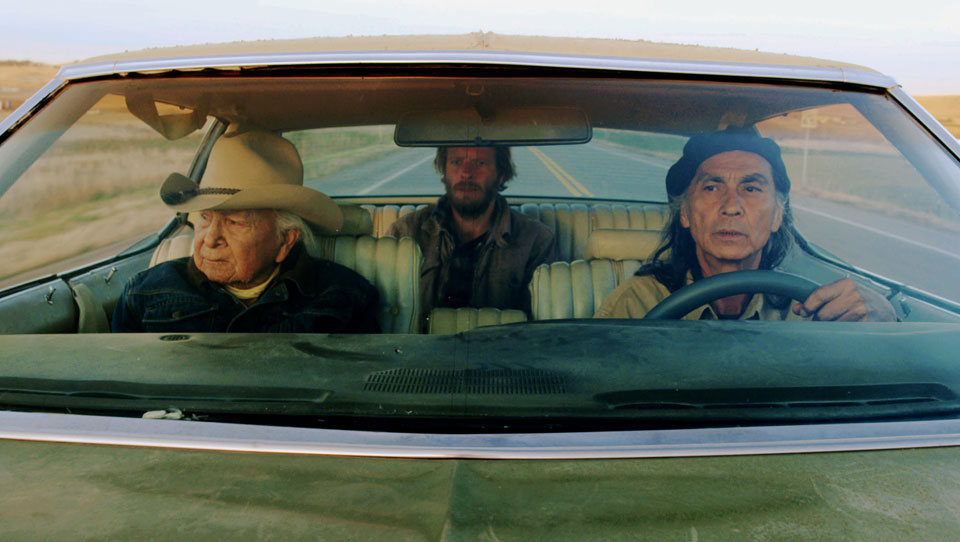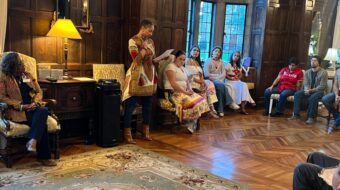
Many readers will recall Kent Nerburn’s Neither Wolf Nor Dog, first published in 1994 and winner of the Minnesota Book award in 1996. Perhaps no other novel so successfully bridged the gap between white America and the Native American world. Almost a quarter of a century later, it still sells well, aided by a wide readership through academic use. The publisher, New World Library, estimates global sales at around half a million copies. The American Indian College Fund said, “This is one of those rare works that once you’ve read it, you can never look at the world, or at people, the same way again.”
Neither Wolf Nor Dog is a new 110-minute film by Steven Lewis Simpson that has already made its powerful impact felt at film festivals and in limited release. Producers were trying to turn it into a movie for 20 years: It had a reputation of being the great unmade contemporary Native American novel. It is now moving into more general release, and if it’s not in your neighborhood soon, watch for it. You will be rewarded.
The story follows the goodhearted liberal white author—Kent Nerburn, played by Christopher Sweeney—who gets sucked into the rhythms and problems of contemporary Native American life in the sparse lands of the Dakotas among the long-suffering Lakota people. Dan, a 95-year-old elder (Dave Bald Eagle) and his sidekick Grover (Richard Ray Whitman) are both his tricky nemeses and his spiritual guides.
Despite the fact that Nerburn is already a fairly successful writer who has sensitively tackled American Indian subjects before, the film is a kind of second coming of age tale. His first attempt to take Dan’s shoebox full of profound notes and pithy observations about life and shape them into a book (at Dan’s own request!) fall flat. Grover describes it as “tom tom bullshit.”
At Dan’s urging, Grover nevertheless agrees to help with the project. He drives them all out to the wilderness and to Nerburn’s horror, sets the shoebox on fire. “Now we’ll do it the Indian way,” Grover states. “Now you’re the box. Now we’re going to fill you up.”
The rest of the film is a combination road trip in a sketchy gas-guzzling 1973 Buick through Dakota Badlands and desolate, barely populated country, and three-way buddy adventure for the three leading men. Stops along the way include a roadside repair shop where Nerburn brings his red pickup truck after it started emitting unexplained “smoke signals.” Also an auntie’s home on the reservation where family members gather and more information about the shoebox is revealed; an old ruined white settler’s homestead, a “frontier town” museum holding artifacts that belonged to Dan’s and Grover’s own people, and a breakfast café with a disturbing encounter with a drunk Lakota man and his girlfriend. The shoebox gone, Nerburn uses a recorder to capture these episodes.
They also visit the site of the 1890 Battle of Wounded Knee and its mournful Indian burial grounds. Here, as Dan recounts his deeply-felt narrative of living with this legacy (he was born only 29 years later), Nerburn for the first time truly grasps the enormity of the crimes committed against Native peoples. Finally he understands why Dan enticed him unwittingly into this journey: Not just to transcribe Dan’s words, but to convey the entirety of their whole racial-historical relationship, including his own enlightenment. Now Nerburn feels he can honestly write this book.
The Scottish-born Simpson has become a well-known advocate for Native American rights and a respected figure in Indian Country. Previous films include Rez Bomb and A Thunder-Being Nation, both set on the Pine Ridge Indian Reservation, and a 13-episode TV show The Hub about arts, culture and entertainment within Indian Country.
Simpson describes the 18-day process of filming: “The pace had to reflect Lakota Country and especially an elder’s reality, which is measured. At the same time, things had to move along so instead of the traditional road movie montages the film resorted to single long frames showing the evolution in the landscape they traversed.”
The director was able to attract an all-star cast featuring almost all Native American actors with broad experience not only in film but in activism. On his death at 97 in 2016, not long after completing filming of Neither Wolf Nor Dog, the native Lakota-speaking David Bald Eagle was referred to on NPR as perhaps “the most interesting man in the world.” His biography cannot easily be summed up here—Google him and see for yourself.
Richard Ray Whitman, as Grover, is a Yuchi-Muscogee/Creek artist, poet, actor and activist who grew up in Gypsy, Okla., where he learned Yuchi as his first language.
About the key role of Nerburn, Simpson says, “Due to the lack of opportunities given to Native actors in Hollywood, there are limited choices to audition for roles. For Nerburn, I could have auditioned hundreds and yet I only auditioned one. I saw Christopher just by chance in a play, ironically at the Native Voices program at the Autry Museum in Los Angeles, where he was the token white guy. [People’s World has regularly reviewed Native Voices productions.] To add to the coincidences, by pure chance, he was born in an Indian Health Services hospital on Yakima Indian Reservation. The only white person I’ve ever heard of to be born in a reservation hospital.”
The film has the aura of authenticity indelibly woven into its fiber. Native beliefs and practices are the rule here: There appears to be no grafting of the white man’s religion onto these lives, which may be explained in part by Dan’s early childhood traumas in church-run boarding schools. Viewers will be educated as to who are the true owners, or “landlords” of this earth.
Nerburn’s father has recently passed away. In his honor, he travels with a sturdy old tote bag carrying the words “Service Before Self,” likely a memento of his father’s charitable work with underprivileged communities. He takes the motto seriously, responding to a call from Dan as service to the call of Native elders, of history, of fate. Yet at Wounded Knee, he has to rethink the slogan. After all, he surmises, not one soldier recoiled from his orders to kill as many Natives as possible. They were “servicemen” too, but in service to whom and to what? “My people did this to your people,” he tells his Native spirit guides.
Other important roles are played by Roseanne Supernault, Tatanka Means, Zahn McClarnon, and Harlen Standing Bear.
Aside from directing the film, Simpson also produced it, is its cinematographer and editor. The script is by Simpson and Kent Nerburn, adapted from the latter’s novel. It was filmed on location mostly at the Pine Ridge Indian Reservation in South Dakota. The trailer can be viewed here.










